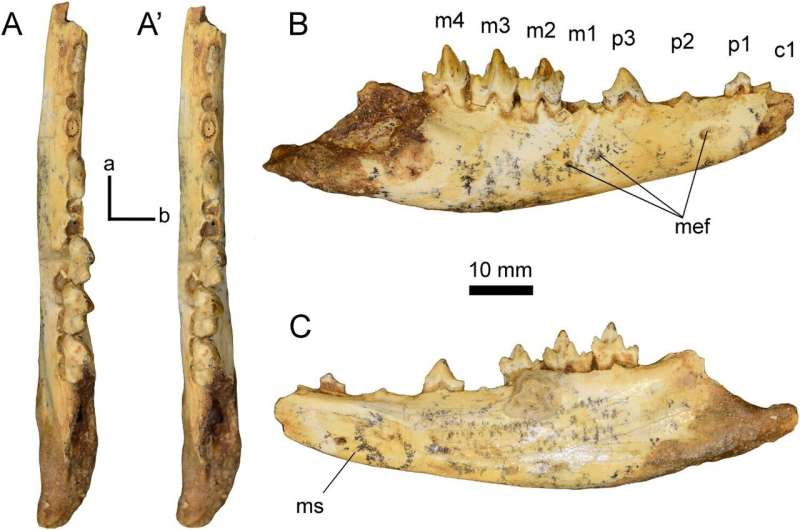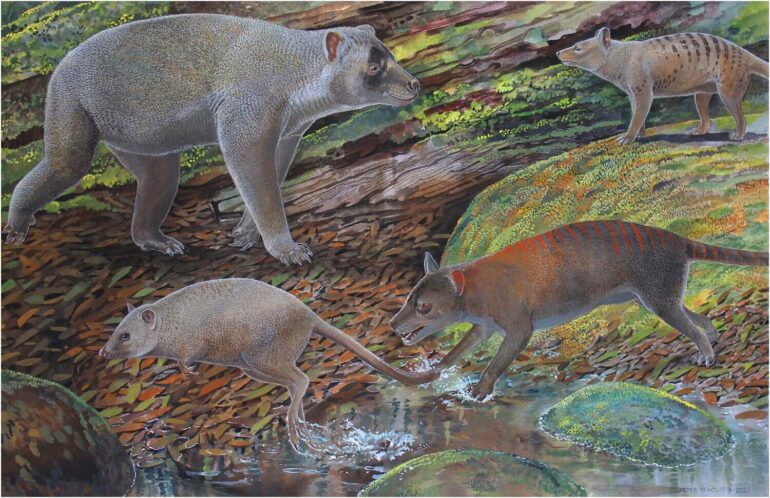Eighty-eight years ago today, the last of the Tasmanian tigers, also known as the Thylacine, died in the Beaumaris Zoo in Hobart. Now scientists are adding three of its oldest ancestors to its evolutionary tree.
Scientists from UNSW Sydney have discovered three new species of Thylacines in fossils unearthed from the Riversleigh World Heritage Area in Waanyi country of north-western Queensland.
In research published today in the Journal of Vertebrate Paleontology, paleontologists say the new species are now the oldest members of the Thylacine family to date, estimated to be 25–23 million years old, making them late Oligocene in age.
Bone crusher
The largest of these new species, Badjcinus timfaulkneri, weighed between 7 and 11 kilograms—about the same size as a large Tasmanian devil. Named after director and co-owner of the Australian Reptile Park and managing director of Aussie Ark Tim Faulkner, this Thylacine adds a new piece to the puzzle of the Tasmanian tiger’s ancestry, says study lead author and Ph.D. student Tim Churchill.
“Like Tasmanian devils, the jaw bone of Badjcinus timfaulkneri could easily crunch through the bones and teeth of its prey,” he says.
“But up until now, the much smaller Badjcinus turnbulli, which weighed around 2.7 kg, was the only other late Oligocene thylacinid known. The teeth—including the lower jaw and isolated first molar—were found at Hiatus Site at Riversleigh, which is even older than White Hunter Site where Badjcinus turnbulli was previously found. This makes Badjcinus timfaulkneri the oldest undoubted thylacine discovered so far.”

Nimbacinus peterbridgei holotype right dentary (QM F61723). © Journal of Vertebrate Paleontology (2024). DOI: 10.1080/02724634.2024.2384595
Forest hunter
The second new member being added to the Thylacine family, Nimbacinus peterbridgei, was slightly larger than a tiger quoll, weighing around 3.7 kilograms. This species was described from a near-complete jaw bone from White Hunter Site at Riversleigh, which is also late Oligocene in age (25–23 million years ago).
“Nimbacinus peterbridgei was a more generalized predator that probably focused on small mammals and other prey species that lived in Riversleigh’s ancient forests,” says co-author Professor Mike Archer.
“We think it may have been on the direct line to the only other species of Nimbacinus, the larger Nimbacinus dicksoni (5 to 7 kilograms) that was found in 15-million-year-old deposits at Riversleigh. This group of thylacines appears to be the one that led directly to the species of Thylacinus.
“The other two new species being described here appear to represent distinctive side branches on the Thylacine’s increasingly complex family tree. This means Nimbacinus peterbridgei is probably the oldest direct ancestor of the Tasmanian Tiger yet known.”
Nimbacinus peterbridgei was named after geologist, speleologist, author and bibliophile Peter Bridge, who has been a long-time supporter of paleontological research at the University of New South Wales.
Meat cutter
The third new member being added to the Thylacine family is Ngamalacinus nigelmarveni. It weighed around 5.1 kilograms, about the size of a red fox. It also came from White Hunter Site at Riversleigh.
“This was a highly carnivorous Thylacine,” says co-author Sue Hand. “We know this because the cutting blades on its lower molars are elongated with deep v-shaped, carnassial—or ‘meat-cutting’—notches. Ngamalacinus nigelmarveni had these notches better developed than any of the other thylacinids of similar size.”
Ngamalacinus nigelmarveni is named after Nigel Marven, a renowned British television presenter known for his captivating documentaries that explore the natural world and prehistoric life such as Prehistoric Park.
Flourish of the marsupials
Churchill says the presence of three distinct lineages of specialized thylacinids during the late Oligocene highlights how quickly this group of marsupials diversified after first appearing in the fossil record.
“These new species exhibit very different dental adaptations, suggesting there were several unique carnivorous forest niches available during this period,” he says. “All but one of these lineages—the one that led to the modern Thylacine—became extinct by 8 million years ago. That lineage ended with the death of Benjamin, the last Tasmanian tiger in Hobart’s Beaumaris Zoo on September 7, 1936.”
Professor Archer says the once suggested idea that Australia was dominated by reptilian carnivores during this 25-million-year long interval is steadily being dismantled as the fossil record of marsupial carnivores, such as these new thylacinids, increases with each new discovery.
Churchill notes that “the diversity of mammalian carnivores at Riversleigh during this period rivals that seen in any other ecosystem, including the great mammalian carnivore radiation that developed in South America.”
More information:
Timothy J. Churchill et al, Three new thylacinids (Marsupialia, Thylacinidae) from late Oligocene deposits of the Riversleigh World Heritage Area, northwestern Queensland, Journal of Vertebrate Paleontology (2024). DOI: 10.1080/02724634.2024.2384595
Provided by
University of New South Wales
Citation:
Three new ancestors added to Tasmanian tiger’s storyline (2024, September 9)



